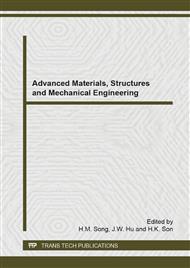p.196
p.200
p.208
p.215
p.221
p.227
p.233
p.241
p.246
Mechanical Properties of PLA/LLDPE Films Reinforced with Silica from Rice Husk
Abstract:
Nanocomposite is one of the most favorable approaches to improve mechanical properties of polymers. This study prepared polymer composite of PLA and LLDPE with different amount of rice husk silica (0.5 and 1 wt%). The composites were prepared by melt-mixing in a twin-screw extruder and processed into film by a chill roll cast extruder. The mechanical properties were investigated through tensile testing and tear testing. The result show that the tensile modulus of PLA decreased with 1wt% rice husk silica. Similarly, tensile modulus of LLDPE dropped with the addition of silica. However, with the addition 0.5 and 1 wt% rice husk silica, the elongation at break of PLA and LLDPE composites increases significantly.
Info:
Periodical:
Pages:
221-226
Citation:
Online since:
September 2014
Authors:
Price:
Сopyright:
© 2014 Trans Tech Publications Ltd. All Rights Reserved
Share:
Citation:


